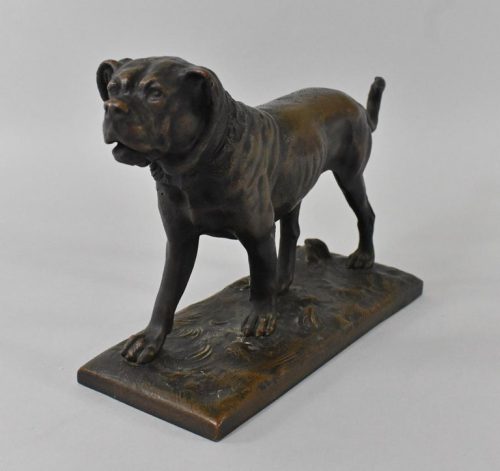
First, a poem:
“How We Took The Great Galleon” by Cicely Fox Smith
Ah, long and long we waited and fretted to be free,
We lay and chaffed in vain, my boys, like bandogs on the chain,
Till there came a mighty galleon, high tow’ring o’er the sea,
And at her masthead flaunted the golden flag of Spain.
Inasmuch as we feel quite civilized for having read a poem that didn’t start with,”There once was a girl from Nantucket,” there is a word in this stanza that is our focus, and we’re betting you already know that the word is “bandogs.”
That word (also seen as “Bandogge”) comes up a lot in the study of many breeds that fall under the umbrella of molloser and bully breeds, but before we tell you what a bandog is, it helps to know where it came from, when, and why.
Kidding. These days, few people know what a “leam” is, but when you learn that a leam was a band of leather used to lead a dog around (in other words, a leash!), Shakespeare’s lines from Act I, Scene IV of King Henry VI make more sense:
“The time when Screech-owls cry,
and Bandogges howle,
And spirits walke, and Ghosts breake up their graces.”
Just as societies needed to differentiate between two people who shared the same first name (leading to surnames), a dog’s function, or in this case, how it was handled, became its name. A big mean dog lead by a band of leather after being uncoupled from a chain became a “band dog” because of that band, or leash. The name “Bandog” was not a breed, then, it was a description of a duty or purpose. If there is any doubt about such a dog’s ferocity, one need only read the statement written by William Harrison when he described England in 1586: “Bandogge which is a huge dog, stubborn, uglier, eager, burthenouse of bodie, terrible and fearful to behold and often more fierce and fell than any Archadian or Corsican cur.”
Early on, bandogs were typically eastern shepherds and mastiffs crossed with Bullenbeissers, hounds, and local bloodlines thrown in, and while appearance was the last thing anyone cared about, over time, specific types were established regionally. By the time the Norman King, Knud the Great, was in power (995 -1035), the Mastiff was cited under forest law, and Dr. Caius “sealed the deal,” as it were, by presenting the Bandogge and Mastiff as one in his book, Of English Dogges: “...among others characteristics, the “Mastiff or Bandogge is serviceable against the fox and the badger, to drive wild and tame swine out of meadows, and pastures, to bite and take the bull by the ears, when occasion so required.”

“Ban dog” was the common term for drovers, i.e. breeds which served to move meat cattle (steers) along with the armies of Europe. Usually mastiff in type, Rottweilers being the most notable and commonly referred to as the butcher’s dog driving the stock to market and the purse of money attached to its collar as protection measure (National Geographic Book of Dogs). However, historical breeds such as the Smooth Collie and Giant Schnauzer also served this purpose, being large enough and DARK in colouration (Coalies) to initiate the prey flight instinct yet calm enough not to stampede the steers. This is the context in which I have most often encountered this term in 6+ decades of reading the fascinating histories of purebred dogs.